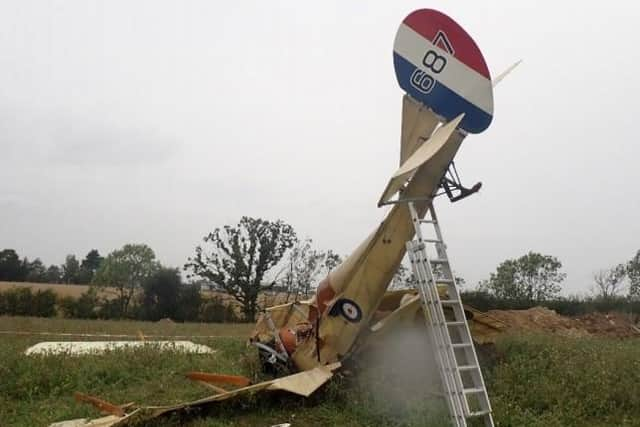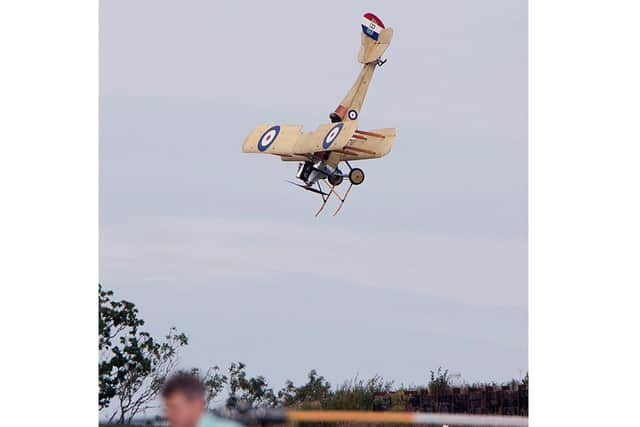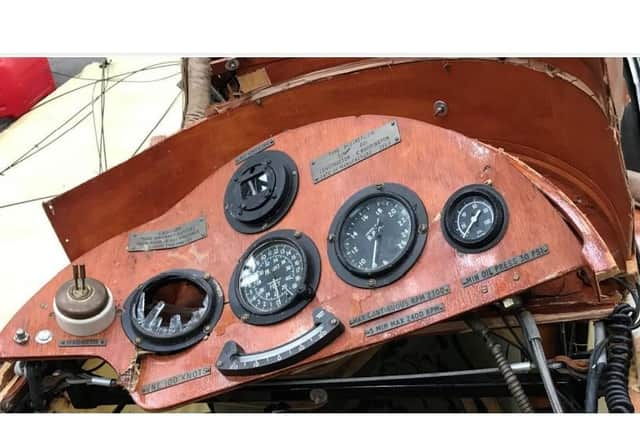Sywell biplane air crash pilot was saved by leather kevlar flying helmet
and live on Freeview channel 276
An official Air Accident Investigation Bureau (AAIB) report into an air crash during a flying display has shown how lucky the pilot was to survive a vertical dive into the ground.
The replica Royal Aircraft Factory BE2c aircraft (G-AWYI) - a Biggles biplane - was practising a flying display with other pilots when it entered a descending right turn and struck the ground nose-down as reported by this newspaper.
Advertisement
Hide AdAdvertisement
Hide AdMiraculously, the pilot, who was sitting in the rear cockpit and wearing a leather covered kevlar helmet was conscious and tried to get out of the aircraft.


He was taken to hospital having sustained a fractured vertebra, broken ribs, severe face lacerations, a broken wrist and broken thumb.
The AAIB report said: "The aircraft was performing a flying display with several other vintage aircraft when the aircraft was seen to enter a descending right turn.
"The aircraft did not recover from the descent and struck the ground in a steep nose-down attitude.
"The pilot suffered serious injuries.


Advertisement
Hide AdAdvertisement
Hide Ad"It is likely that the aircraft entered a spin, although the possibility that the initial departure was a spiral dive could not be eliminated.
"The reason for the departure from controlled flight could not be determined. No pre-existing mechanical defects were found with the aircraft or engine."
One pilot who was orbiting at 600ft with the BE2c biplane (G-AWYI) waiting to get into position for the display said that G-AWYI and his aircraft were not in the ideal position and would need a large turn to formate behind them.
He told the AAIB that when he saw G-AWYI roll into the right turn he recalled thinking that the roll was ”a bit harder than normal”, he commented that the pilot normally flew the aircraft very gently and this was just a bit more “spirited” than normal.


Advertisement
Hide AdAdvertisement
Hide AdHe described seeing the wing drop and the aircraft entering what he thought was a spin.
He recalled that the manoeuvre appeared to be very gentle and he expected to see the rotation stop and the aircraft recover.
However, the rotation did not stop, and he saw the aircraft continue to descend to the ground.
The pilot reported to the AAIB that he applied full power and believes he applied out-of-turn rudder.
Advertisement
Hide AdAdvertisement
Hide AdHe had a clear memory of pulling back on the control stick and the wing dropping again. His next memory was the “nose going straight down and the aircraft not responding” and feeling like “the aircraft wasn’t flying anymore”.
The pilot thought that the aircraft had entered a spin rather than a spiral dive as it did not feel like the aircraft was accelerating.
The display team had not been able to practise due to the Covid pandemic and September 2 was the first display practice of the 2020 season.
In the AAIB report it said: "During the display the six aircraft fly a series of choreographed manoeuvres and flypasts to simulate a First World War dogfight.
Advertisement
Hide AdAdvertisement
Hide Ad"To ensure safe separation between the aircraft during the display, the display area is divided into two halves.
"On the morning of the accident the six pilots met for a pre-flight briefing. This was followed by three walk-throughs of the display routine to ensure each pilot understood the planned display.
"One of the team then briefed the Flight Information Service Officer in the control tower on the planned display and agreed a display time."
The six aircraft took off at 10.29am and commenced the display.
Advertisement
Hide AdAdvertisement
Hide AdAfter the first few manoeuvres, G-AWYI and a Fokker DR1 were holding position flying orbits at 500 to 600 ft to the right of crowd centre.
The plan was for the pair to position behind a Sopwith Tri-plane and another Fokker DR1 as they flew back down the display line.
However, G-AWYI was seen to enter a descending right turn from 500 to 600 ft.
The aircraft continued in the steep descending turn, completing two and half rotations, before it struck the ground. The accident occurred at 10.38am.
Advertisement
Hide AdAdvertisement
Hide AdWhen the display leader realised an accident had occurred the display was stopped, and the five other aircraft landed safely.
During the display the airport fire service wait in their vehicles ready to react if an incident occurs.
The fire crew saw the aircraft descending and started driving towards the area before the aircraft had struck the ground. They were on site quickly and were able to assist the pilot.
The AAIB report added: "The pilot was sat in the rear cockpit and although the aircraft struck the ground in a near vertical attitude distorting the fuselage structures, a survival space remained.
Advertisement
Hide AdAdvertisement
Hide Ad"There was no post-impact fire. The rear instrument panel had fallen into the front cockpit reducing the survival space available, had the cockpit been occupied. The pilot was wearing a kevlar flying helmet with a leather cover to make it look more authentic for a vintage aircraft."
It concluded: "Whilst orbiting at low-level it is likely that the aircraft entered a spin, although the possibility that the initial departure was a spiral dive could not be eliminated.
"It was not possible to determine the reason for the initial departure from controlled flight. It is likely that the pilot started to recover but tried to pitch up before the aircraft had built sufficient airspeed leading to a secondary spin.
"The pilot was wearing a kevlar flying helmet and it is likely this prevented him from suffering further serious injuries.
"There was no evidence of any mechanical fault which could have contributed to the accident."